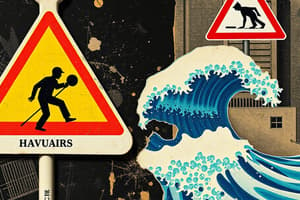Podcast
Questions and Answers
What is the formula to determine disaster risk according to the text?
What is the formula to determine disaster risk according to the text?
- R = H + V / C
- D = H x V / C
- D = H / V
- R = H x V (correct)
What does the disaster formula D=HxV stand for in the context provided?
What does the disaster formula D=HxV stand for in the context provided?
- Disruption equals Hazard multiplied by Violence
- Death equals Hazard divided by Vulnerability
- Disaster equals Hazard multiplied by Vulnerability (correct)
- Damage equals Hazard multiplied by Volatility
In the scenario mentioned, what are some effects of a strong earthquake at Manila Bay?
In the scenario mentioned, what are some effects of a strong earthquake at Manila Bay?
- Heavy rainfall and flooding
- Liquefaction and landslides causing severe damage (correct)
- Heatwaves and drought
- Tornadoes and hailstorms
What determines whether a community is high risk or low risk?
What determines whether a community is high risk or low risk?
What is the primary focus of educating people in relation to disaster risk as per the text?
What is the primary focus of educating people in relation to disaster risk as per the text?
What does the text suggest about the possibility of preventing disasters?
What does the text suggest about the possibility of preventing disasters?
What stage of disaster involves separating sick people with contagious diseases from those who are healthy?
What stage of disaster involves separating sick people with contagious diseases from those who are healthy?
Which socio-temporal stage of disaster refers to the arrival of organized and professional relief, medical care, and security measures?
Which socio-temporal stage of disaster refers to the arrival of organized and professional relief, medical care, and security measures?
What impact can natural disasters have on healthcare facilities?
What impact can natural disasters have on healthcare facilities?
In the context of disaster recovery, what does the 'Cash for work' initiative entail?
In the context of disaster recovery, what does the 'Cash for work' initiative entail?
What is the significance of the Philippines being situated in the Pacific Ring of Fire?
What is the significance of the Philippines being situated in the Pacific Ring of Fire?
During which socio-temporal stage of disaster do preventive measures against recurrence become a focus for the community?
During which socio-temporal stage of disaster do preventive measures against recurrence become a focus for the community?
What makes the Philippines vulnerable to earthquakes?
What makes the Philippines vulnerable to earthquakes?
Which earthquake in Philippine history caused the most casualties?
Which earthquake in Philippine history caused the most casualties?
What organization conducted the Metro Manila Earthquake Impact Reduction Study?
What organization conducted the Metro Manila Earthquake Impact Reduction Study?
How many times has the West Valley Fault moved within the last 1,400 years?
How many times has the West Valley Fault moved within the last 1,400 years?
What is the nickname given to the anticipated 7.2 magnitude earthquake along the West Valley Fault?
What is the nickname given to the anticipated 7.2 magnitude earthquake along the West Valley Fault?
What was the purpose of the Philippines requesting assistance from Japan for the Metro Manila Earthquake Impact Reduction Study?
What was the purpose of the Philippines requesting assistance from Japan for the Metro Manila Earthquake Impact Reduction Study?
Flashcards are hidden until you start studying
Study Notes
Disaster Risk Formula
- Disaster risk can be determined using the formula D = H x V, where D represents disaster risk, H indicates hazard, and V signifies vulnerability.
Effects of Strong Earthquake at Manila Bay
- A strong earthquake at Manila Bay can lead to widespread devastation including significant property damage, loss of life, and disruption of services.
Community Risk Levels
- A community's risk level is determined by its exposure to hazards, infrastructure resilience, preparedness measures, and social vulnerability.
Focus of Disaster Risk Education
- Educating people primarily focuses on enhancing awareness and preparedness to mitigate the impacts of disasters.
Possibility of Preventing Disasters
- While it is not feasible to prevent disasters entirely, strategies can be implemented to reduce their impact and enhance resilience.
Stage of Disaster Involving Contagious Diseases
- The stage of disaster that involves separating individuals with contagious diseases from healthy individuals is known as the response stage.
Professional Relief and Medical Care Arrival
- The arrival of organized and professional relief along with medical care signifies the recovery stage of a disaster.
Impact of Natural Disasters on Healthcare Facilities
- Natural disasters can severely damage healthcare facilities, disrupting services, and impacting patient care and responses to emergencies.
'Cash for Work' Initiative
- The 'Cash for Work' initiative involves providing financial compensation to individuals for participating in reconstruction and rehabilitation efforts after a disaster.
Philippines and the Pacific Ring of Fire
- The Philippines is located in the Pacific Ring of Fire, making it highly susceptible to earthquakes due to tectonic activity.
Preventive Measures Focus
- During the recovery stage, communities focus on implementing preventive measures to reduce the likelihood of future disasters.
Vulnerability to Earthquakes
- The Philippines is vulnerable to earthquakes due to its geographic position on tectonic plates, which are actively moving.
Deadliest Earthquake in Philippine History
- The most casualties in Philippine history were caused by the 1976 Lake Talayan Earthquake.
Organization for Earthquake Impact Study
- The Metro Manila Earthquake Impact Reduction Study was conducted by the Japan International Cooperation Agency (JICA).
West Valley Fault Movement
- The West Valley Fault has moved approximately 6 times in the last 1,400 years.
Anticipated Earthquake Nickname
- The anticipated 7.2 magnitude earthquake along the West Valley Fault is commonly referred to as "The Big One."
Purpose of Assistance from Japan
- The Philippines requested assistance from Japan to enhance disaster preparedness and risk reduction strategies through the Metro Manila Earthquake Impact Reduction Study.
Studying That Suits You
Use AI to generate personalized quizzes and flashcards to suit your learning preferences.






